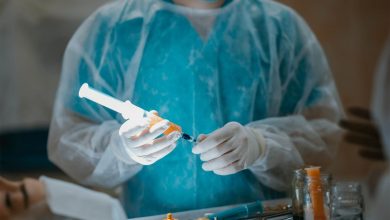What is Silicone Implant Replacement (Renewal) Surgery?
Silicone replacement (renewal) surgery is a plastic surgery procedure performed on individuals who have previously had “breast augmentation surgery with silicone implants”, which is intended to remove the existing silicone breast implant and then placing a new one.
Silicone breast implant replacement surgery can be performed entirely based the patient’s aesthetic preferences, even if it is not necessary, but in some cases, it is needed due to some medical and aesthetic complications.
While deciding on the shape, surface feature, and size of the new silicone implant, many factors are taken into account depending on the reason for the replacement of the existing silicone.
According to a 2011 report issued by the Food and Drug Administration (FDA) in the United States, 1 out of every 5 patients who had silicone implants had their implants replaced within 10 years after the placement surgery for a compelling reason such as capsular contracture or implant rupture.
What Are the Causes of Silicone Implant Replacement (Renewal) Surgery?
- The patient’s request for an implant larger or smaller than the existing one
- The patient’s request for an implant different from the existing one (such as a round type instead of a teardrop type ).
- The patient’s request for an implant with a surface feature different from that of the existing one (such as a smooth-surface implant instead of a textured-surfaced implant).
- The patient’s request for the replacement of an implant that was placed many years ago, with a new model silicone implant, even though she has no complaint.
- A decision made on the renewal of the implants during a breast lift operation.
- Silicone implant rupture
- Capsular contracture development around the silicone implant.
- Slippage or displacement of the silicone implant on the anterior chest wall (if the implant is too large that needs to be replaced with a smaller one).
- Rippling of the breast (if there is a need to change the size or surface feature of the implant).
Breast shapes obtained after breast augmentation surgery with silicone implant are not permanent for life. Breast shape changes over time due to factors such as the effect of gravity, pregnancy and weight gain and loss. In addition, women’s perceptions of mammoplasty may change over time, and they may desire breasts larger or smaller than what they currently want.
Even when there no problem with the silicone implants, the breast tissue covering the implant may begin to sag and loosen, requiring a breast lift surgery. During this surgery, silicone implants can be left in their places or they can be replaced with new ones. If it has been 5-10 years since the first surgery and/or if a new silicone implant with a different shape, size, or surface characteristics is wanted, the implants are also replaced during the breast lift surgery.
Silicone implant rupture is one of the conditions that definitely require the replacement of the silicone breast implant. Today’s most common silicone implants are structures having a silicone or polyurethane sheath, filled with gel-like medical silicone. As a manufacturing defect, silicone prostheses may rupture and its contents may leak into its surroundings due reasons such as the wear of the sheath over the years, a surgical error, a trauma to the implant, etc.
In such a case, the ruptured implant and its contents are surgically removed, the capsule contracture (if any) is eliminated and the pouch in which the implant is located is cleaned, and a new implant is placed in the same or a newly created pouch. This procedure is referred to as silicone breast implant replacement (or renewal) surgery.
How Can a Silicone Implant Problem Be Noticed?
If you have any of the following complaints, signs, or symptoms in your breasts, you should see your doctor to investigate the possible complications:
- Pain
- Stiffness
- Deformation
- Swelling
- Implant that is not soft and mobile as before
- Asymmetry between the breasts
- Redness and tenderness of the breast skin
- Tingling or burning sensation
- Numbness or a changed sensation in the nipple or breast skin
- Palpable mass that did not exist before.
- Palpable mass under the armpit
- Displacement of the implant on the anterior chest wall
- Rippling of the breast skin.
Among the possible complications, the most important one is the disorder called “Large Cell Lymphoma” that develops around the silicone implant. Although this condition is quite rare, it can be fatal when not diagnosed and treated in time.
Sometimes a problem may develop without the complaints or symptoms listed above. As a result, anyone who has had silicone implant breast augmentation surgery should examine herself on a regular basis, have routine breast examinations even if she has no complaints, and be checked with a breast MRI at least once every two years.
How is A Silicone Rupture (Ruptured Silicone implant) Noticed?
In most cases where the outer sheath of an implant ruptures for any reason in a person who has had breast augmentation surgery with silicone implants, the patient is unaware of the condition because it does not cause any obvious symptoms. This condition is called “silent rupture”.
Sometimes, a variety of symptoms and complaints are observed due to the leakage of the silicone gel inside an implant, i.e. silicone rupture. The primary ones among these are;
- Capsular contracture around the implant, and the associated breast pain, tenderness, stiffness, deformity and asymmetry
- Palpable masses in the breast
- Pain in the breast.
Based on the results of some tests performed when a patient with the signs and symptoms listed above visits her physician, it is investigated whether there is a rupture in the silicone implant. If there is a rupture, the problem is resolved with a silicone implant replacement operation.
How is Silicone Rupture (Ruptured Silicone implant) Diagnosed?
Even if there are no complaints, it is recommended that patients have a routine breast MRI 3 years after breast augmentation with silicone implant, and then repeat this examination once every two years.
With breast MRI, the breast tissue, the silicone implant and the capsule tissue surrounding the implant are evaluated in terms of potential late complications. Problems such as silent silicone implant rupture or large cell anaplastic lymphoma in the capsule tissue, which have not yet manifested itself clinically, can thus be identified at an early stage.
If the aforementioned signs and symptoms exist, the plastic surgeon conducts a physical examination and clarifies the condition by requesting additional tests, such as a breast MRI or ultrasonography. If a silicone rupture is identified, the problem is solved with silicone breast implant replacement surgery.
Is Silicone Breast Implant Rupture Dangerous?
Ruptures of the outer sheath of silicone breast implants and the leakage of the gel inside them may cause symptoms, but symptoms caused by implant ruptures do not include breast cancer, reproductive system-related diseases, or connective tissue diseases such as rheumatoid arthritis.
With silicone breast implant replacement surgery, the ruptured implant is removed, the capsule contracture (if any) is eliminated, the pouch in which the implant is located is cleaned, and a new silicone implant is placed to solve the problem
What Happens If a Silicone implant Ruptures?
If the silicone breast implant ruptures for any reason, that is, if the outer sheath ruptures and the silicone gel inside the implant leaks. In some cases, such an implant can stay there for years without causing any complaints. In some other cases, the leaking silicone gel may pass through the surrounding capsule tissue or the breast tissue, causing some foreign body reactions.
The immune system of the body is triggered, resulting in the problems mentioned above, such as capsule contracture, calcification, breast deformity, asymmetry, pain, etc. Therefore, it is necessary to remove the ruptured implant and replace it with a new one by performing a “silicone breast implant replacement operation”.
Should Silicone Breast Implant Ruptures Be Treated Urgently?
Silicone implant rupture is not an emergency condition that should be treated within hours or days. However, it would be the appropriate approach to replace the ruptured implant with a “silicone breast implant replacement operation” at an opportune time.
How Is A Silicone Breast Implant Replaced?
It is mostly done under general anesthesia in an operating room. If an additional surgical procedure such as breast lift is not considered, the surgical scar left by the previous breast augmentation surgery is used. The pouch containing the implant is accessed through an incision made on this scar, and the implant is removed.
If there is an implant rupture, the pouch is thoroughly cleaned. If the pouch where the implant is placed has a capsule contracture, the capsule tissue is partially or entirely removed. In some cases, the existing pouch is reshaped, and in some other cases a new pouch is created. Finally, the new silicone implant with desired size, shape, and surface is placed in the pouch.
If a breast lift or reduction is to be performed in conjunction with the silicone implant replacement, the implant is replaced by making new incisions on the breast skin, in accordance with the surgical technique to be used.
The length and difficulty of a silicone breast implant replacement operation are directly proportional to the reason for the implant replacement. Placing a larger implant can be quick and easy, but in more complex cases where there is a silicone rupture and capsular contracture, procedures like cleaning the capsule tissue or preparing a new pouch can lengthen and complicate the operation.
Capsule Contracture Development Around A Breast implant
Excessive capsule tissue development around the implant is one of the most common reasons for silicone implant replacement. This hard tissue causes complaints such as pain, stiffness, deformity and asymmetries in the breast. In most cases, implants and the pouches where they are located need to be replaced. You can find more detailed information about this subject in our blog post entitled “capsular contracture around the silicone implant”.
Silicone Implant Displacement
The problem of silicone implant displacement (shifting) is one of the conditions that require silicone breast implant replacement surgery. Silicone implant displacement is referred to as the slippage of a breast implant on the anterior chest wall from where it should be to another place. Displacement of extreme large implants downward or outward is a common condition.
In such a case, the large implant is removed, the pouch is repaired, and then a new implant of more normal size is placed. You can find more detailed information about this subject in our blog post entitled “silicone implant displacement”.
Rippling Problem in Breasts with Silicone Implants
The rippling appearance in a breast that has undergone breast augmentation surgery can be caused by variety of reasons. In some cases, the treatment can be performed by replacing the breast implant. You can find more detailed information about this subject in our blog post entitled “Ripling Problem”.
Is Silicone Breast implant Replacement Surgery Essential?
If you have no complaints and no problems were identified during your routine breast MRI tests, you don’t have to have a silicone breast implant replacement surgery.
Are Silicone Implants Permanent?
The durability of silicone breast implants has increased even more as a result of evolving technologies used in their production. Silicone implants can stay in place for life as long as their removal is not medically or cosmetically necessary. Many manufacturers offer a lifetime warranty, and replace the ruptured implant for free if the problem has been caused by wear.
At What Intervals Should Silicone Implants Be replaced?
There is no specific period of time for the replacement of silicone implants. As long as no complications are observed, silicone implants can remain unchanged for life.
Do Silicone implants Wear Off?
The outer sheath of silicone implants wears off over time. The sheath of the implants produced in recent years is more durable, and this kind of wear rarely causes a problem.
How Do Weight Changes Affect Silicone implants?
Changes in body weight, such as excessive weight gain or loss, have no direct effect on the silicone implant, but they affect the breast tissue surrounding the implant and the aesthetic appearance of the breast. Breast sizes increase even more as a result of weight gain. In case of weight loses, the tissue covering the implant thins, increasing the risk of the implant being noticed from the outside.
In addition, in people who gain and lose weight frequently, the ligaments that keep the breast skin and tissue in place become looser, causing the appearance of sagging breasts. Over the years, the breasts that are already slightly drooping due to gravity and implant weight sag more to an extent that requires a “breast lift” surgery.
When Should Silicone implants Be Removed?
If you have no aesthetic or medical problem with your implants, you can keep them in place for life; in other words, there is no need to remove them after a certain period of time.
What Does “Silent Rupture of Silicone Breast Implants” Mean?
It is a condition in which the patient shows no signs or symptoms despite the rupture of the outer sheath of the silicone implant. The rupture of the implant can only be noticed by chance during routine examinations such as breast MRI, ultrasonography, or mammography.
On our webpage “Breast Augmentation Surgery”, you can find more information about breast augmentation surgery with silicone breast implants, and the answers to frequently asked questions.
Costs of Silicone Breast Implant Replacement (Renewal) Surgery in 2024
The cost of silicone implant replacement (renewal) surgery is not standard. The answer to the questions of whether only the old prostheses will be replaced with the new ones, or whether additional surgical procedures such as breast lift or capsule removal will be required, directly influence the cost of the operation.
The complexity of the problem causing the silicone breast implant replacement surgery, as well as the type and brand of the silicone implants to be used, also influence the cost. By contacting our office, you can learn whether you need silicone breast implant replacement surgery, if so, what type of surgical procedure will be performed, and the current cost of surgery.
References




